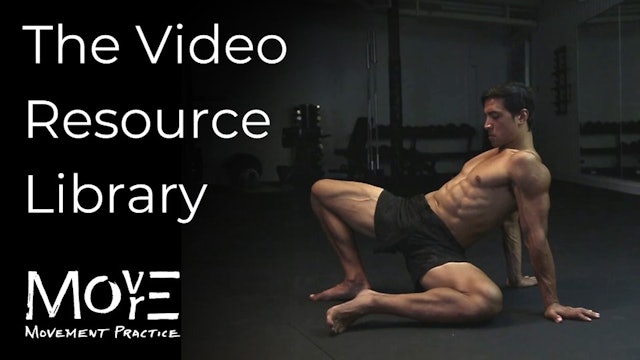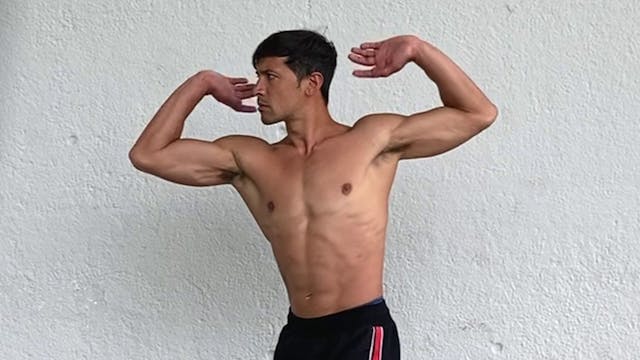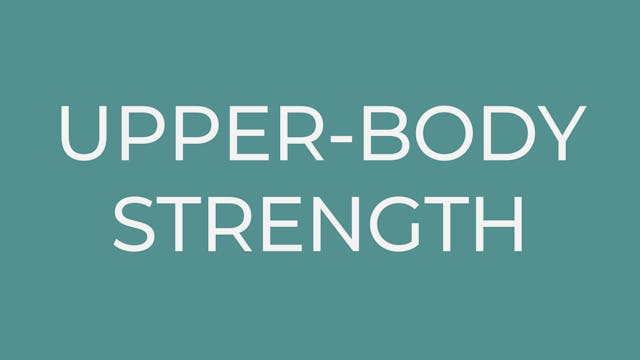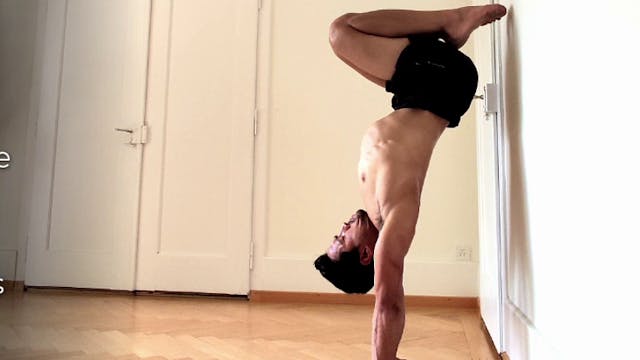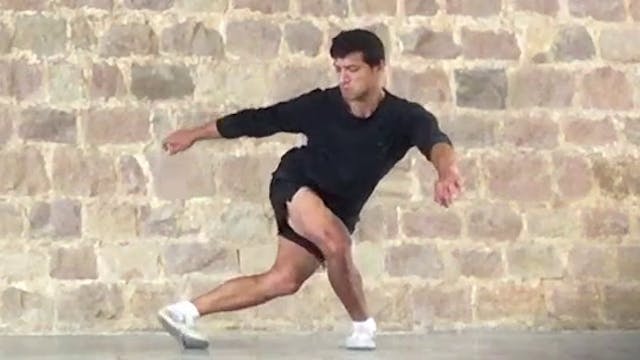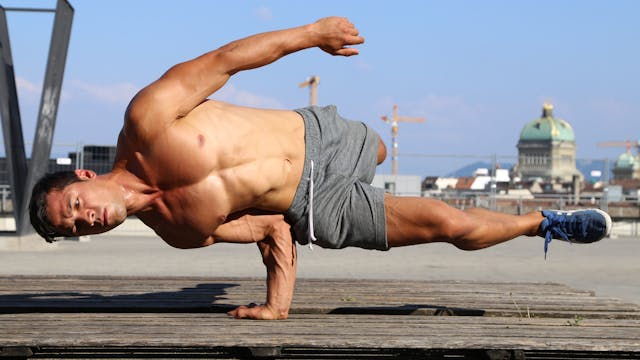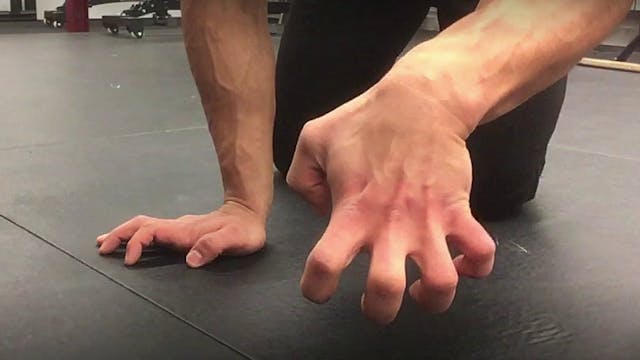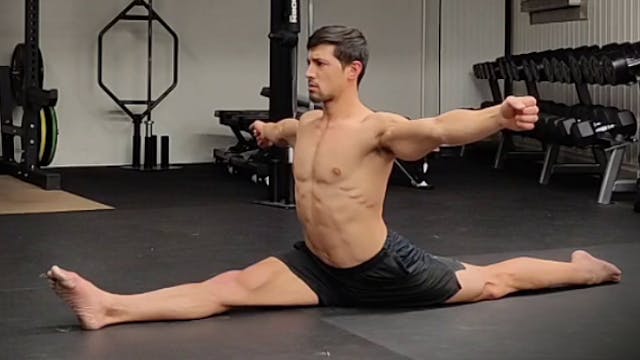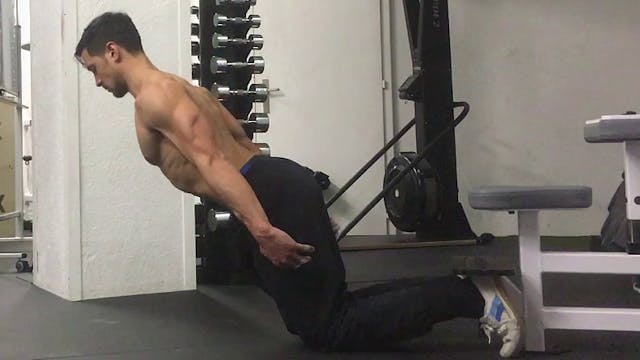FULL ACCESS to the 'MoveMore: VRL'
$55 a month or $495 a year
Now you can access the 'MoveMore: Video Resource Library (VRL)' via monthly or yearly subscription, including ALL ongoing material releases. Subscribers receive:
.
📺 Full access to 500+ video resources sharing THOUSANDS of contexts for practice, plus all future releases
📝 Extensive ESSAYS on movement-subjects + notes & 'PROGRAMMING recommendations' for EVERY context
🗺️ User-friendly interface, "mapping" the physical-practice across 10+ 'macro' and 45+ 'micro' subjects
📝 Supporting video-lectures on how to write & structure a developmental physical-practice
♾️ Exposure to interconnected concepts & principles informing a wider 'Movement perspective'
🌎 Access to community 'Forums' supporting engagement, discussion, Q&A and "troubleshooting" in practice
.
A unique physical-education platform, the 'VRL' is designed for self-directed use by movement professionals, teachers, coaches, practitioners, and enthusiasts alike. It provides guidance, yet freedom, to design progressive pathways according to the goals, experience, and interests of the individual with the objective of nurturing a sustainable "Movement-practice".
.
The library opens with OVER 500 video resources sharing THOUSANDS of carefully-curated contexts, protocols, routines & exercises each informed by an interconnected web of concepts, principles and perspectives. In this way, it encourages the consideration & cultivation 'Movement' as a subject for intellectual-study and physical practice.
.
Organisation across 10+ macro 'CATEGORIES' and 45+ micro 'COLLECTIONS' gives resources a distinct structure, subject-matter, and relationship, facilitating better conceptual "mapping" of the terrain of practice as well as a user-friendly experience. Further, each subject and EVERY resource is informed by further learning material in .pdf format.
.
This includes exclusive PROGRAMMING RECOMMENDATIONS and extensive supporting notes which teach not only the "what & why", but also CONTEXTUAL placement within the wider practice physical development from a 'Movement perspective. This learning is further supported by community FORUMS whereby practitioners can connect, discuss, and engage directly through & with the platform.
.
Whether to inform your independent practice or sharing with others in your local movement network, the 'MoveMore: VRL' serves as an extensive reference-platform supporting physical-education & development of your movement potential.
.
.
.
.
.
PLEASE NOTE:
As a platform for SELF-DIRECTED practice, whilst programming recommendations are provided this subscription does NOT include any pre-written programs, nor resources for 'Breathing & Diaphragm' practice. Standardised programs are available from the 'Elements' store: www.movemoremp.com/elements
-
Quadrupedal patterns & conditioning
16 videos
THE WHAT:
The practice of ‘quadrupedal-locomotion’ is most generally concerned with movement through space on “all-fours”, sharing weight between both the feet AND the hands. In comparison to BI-pedal patterns, then, this is certainly not a natural way for humans to locomote, and, in trying to lo... -
Gross & fine motor-control
9 videos
Contexts of practice which will request the refinement of motor-control across the entire body, whether "gross" (i.e. globally or across the 'large-frame'), "fine" (e.g. micro-movement to maintain an object or one's own structure in balance), or a combination of the two. Refer to each specific ta...
-
UBS skill-trees .pdf's
0 videos — 9 extras
Skills trees for UBS / BAS, SAS, SASS (Levels 1-4) in .pdf format, directly linked to the VRL. Open download below:
UBS / BAS (L1): https://drive.google.com/file/d/1JQ2vWtiGxRllXMTUZxIfZkdk0bQhWuOv/view?usp=drive_link
UBS / BAS (L2): https://drive.google.com/file/d/1RJ70zcyCd8JZwBPXDfAtgXGJOfP1x... -
LBS skill-trees .pdf's
0 videos — 4 extras
Skills trees for LBS (Levels 1-4) in .pdf format, linked directly to the VRL. Open download below:
LBS (L1): https://drive.google.com/file/d/14-tBc-ph59Ioox97W_P8sr0RFBmbrKTT/view?usp=drive_link
LBS (L2): https://drive.google.com/file/d/1kTLEDpz0D24p4rtZo6ICeU3DzsmH6xGC/view?usp=drive_link
LBS (... -
Timing, rhythm, and coordination
13 videos
Movement tasks which both request & develop subtle & interconnected attributes of rhythm, timing, and coordination to achieve successfully. Whether just the body moving in/through space or in connection with an object, the effective rhythm/s must firstly be noticed identified, and internalised. T...
-
Spine & scap: 'local' & integrated patterns
10 videos
Developing a vocabulary of "isolated" spinal-patterns on the local-spine level & integrating them
More supporting info SOON. -
Spinal-stability & auxiliary "core" conditioning
18 videos
-
Handstand entry & exit
6 videos
Before being able to balance in a handstand, you must learn to enter. Generally an certain entrance is chosen because it is conducive to the specific balancing form which follows. E.g. a straight-leg kick-up into straight-line allows for immediate alignment of the legs, as well as travelling the ...
-
Handstand alignment drills
9 videos
Before taking to inversion, we first need to begin developing an embodied understanding of the form which we will ultimately practice bringing to balance. Handstand alignment drills are therefore not only integral to the beginner's practice (and should be heavily invested in), but will also serve...
-
Handstand supported-alignment
11 videos
At the same time as managing mobility restrictions and developing an understanding of the fundamental structure of an "aligned" handstand, you can immediately begin to build experience in an inverted position by practicing 'supported-alignment' drills. This is where we first begin to approach and...
-
Handstand supported-balance
8 videos
Once a fundamental understanding of 'alignment' and structural awareness in straight-line and tuck forms and a foundational capacity for holding in inversion has been developed, the ongoing work of "finding" balance can commence. Whilst for those with existing experience in inversion (whether sta...
-
Handstand balance contexts
15 videos
These handstand-balance contexts provide years of practice toward developing both linear (i.e. extending the capacity for time in balance) and lateral (exposure to a range of contexts) experience in the two-arm handstand. As well as exploring different forms and leg positions which serve to heigh...
-
Press HS & Stalder press
19 videos
Whilst fundamentally dependent upon the ability to balance in a handstand and an embodied understanding of the structure and mechanics required to do so, ‘Press-handstand’ variations and the ‘Stalder press’ ultimately belong to the bodyweight practice of ‘straight-arm scapular/strength’ (SAS/S) p...
-
Floor-entrance (FEN) & floor-exit (FEX) patterns
18 videos
As a loosely applied-term, ‘floor-entrance’ (FEN) and ‘floor-exit’ (FEX) describes patterns and sequences which transition through “levels” in space toward the floor. Whilst some move simply from standing (bipedal) to quadruped (i.e. to contact with the hands also), others descend into full floor...
-
Floor-contact locomotion & transitions
12 videos
In order to develop an interconnected & usable vocabulary of floor-contact locomotion, further to the availability of floor-entrance & floor-exit (FEN/FEX) patterns the attention necessarily shifts to developing movement optionality once the practitioner is on the floor. Quite simply, we begin wi...
-
Floor-contact sequence & impro
7 videos
Having learnt certain isolated patterns and “floorwork” concepts, the space opens up to begin putting them together and truly “driving” the body through space, in floor-contact. Whilst this can be undertaken at any stage of practice and should not be dressed in the guise of some “ultimate level”,...
-
Bipedal patterns & conditioning
21 videos
THE WHAT:
The practice of ‘bipedal-locomotion’ is most generally concerned with movement through space, on two legs. Beyond the gradations between walking and running, however, the legs have the potential to move in more “complex” ways than this alone, opening up a subject of practice in which a ... -
Locomotion integration, sequences & impro
17 videos
This collection of resources presents just a few possibilities of ‘bipedal’ & ‘quadrupedal’ locomotion integrations, with an eye toward developing an “embodied” proficiency to express them whilst moving “freely” (i.e. at the practitioner’s own will and direction) through space – i.e., ‘improvisat...
-
Groundwork patterns & conditioning
14 videos
THE WHAT:
‘Groundwork’ outlines an area of floor-communication characterised by transitions & locomotion patterns which oscillate, in, out of, and through the ‘squat’ form whilst innately shifting weight between the hands & feet. This area differs from ‘quadrupedal-locomotion’ firstly in that it ... -
Groundwork integrations
17 videos
THE WHAT:
Whilst ‘integrations’ are present in both areas of ‘Locomotion’ and ‘Floorwork’ aspects of the greater ‘Floor-communication’ category, in the practice of ‘Groundwork’ they are deserving of a collection entirely to themselves. This is because, unlike their aforementioned counterparts, th... -
Groundwork sequences & impro
8 videos
Whilst, as with other areas of ‘Floor-communication’ practice, the quality of individual patterns and connected integrations can continually be developed in the practice of extended sequences and even during improvised contexts, in an ideal scenario this requirement should be MINIMAL. Rather, the...
-
RE-/PREHAB: Shoulders, scap & neck
21 videos
WHAT YOU NEED & WHAT YOU DON’T:
As with other ‘Re-/prehab’ collections, there is some resource-crossover with collections concerned with capacity & strength-development, such as ‘Fundamental hanging’ contexts in the practice of straight-arm scapular-strength (SASS) development, or with patterning... -
RE-/PREHAB: Fingers, wrists. forearms & elbows
20 videos
The arms & hands function as our body’s physical “manipulators”, allowing us to interact with our environment and the objects within it in a range of complex ways. As with the shoulder, this “complexity” is represented in freedom to move and affords both the wrist-articulation, and therefore hand...
-
PRE-/REHAB: Feet, ankles, knees & hips
22 videos
In establishing our verticality under the constant of gravity, the base and initiation of all movement from our standing position is expressed in the connection of our feet, to the floor. Even restrictions in the range of toe-extension, then, can influence and are influenced by the state of conne...
-
Manual-therapy & self myofascial-release (SMR)
13 videos
Fundamental resources for diagnosing, treating, and mitigating hypertonicity in areas of the body which can commonly hold a greater than desirable level of resting tone. Whether from lifestyle or practice habits, if left untreated, what can begin as "superficial-blockages" affecting the muscles &...
-
Shoulder-mobility (range-development)
19 videos
A “COMPLEX” SUBJECT:
Restrictions to the range of shoulder-movement, and therefore developing them, can be as complex as the shoulder-articulation itself; relative to the ball & socket joint of the hip, for example, the humeral-head (i.e. of the upper-arm) sits extremely shallow in the glenoid fo... -
BW 'front-folding'-range
12 videos
‘Front-folding’ is a form in which the body is maximally flexed in the hips & lumbar-spine, so as to “pull” the upper-body & face maximally toward the shins. It is more distinguishable as the feet-TOGETHER ‘Pike’ form, as opposed to the STRADDLED legs of the ‘Pancake’, as whilst the latter does “...
-
Weighted mobility development
18 videos
'Weighted' mobility development contexts utilise an external load to help enter end-ranges of motion and develop strength there. Whilst they are generally dynamic (i.e. moving in & out of the end or through the full range with both a concentric and eccentric phase), loaded static forms (e.g. 'Hor...
-
Fundamental squat & hip-mobility development
23 videos
The phrase “fundamental human-ranges” is not one thrown around so lightly as, despite the potential to invest in a variety of forms for mobility-development (from ‘global-extension’ & ‘front-folding’ to ‘leg-abduction’ & ‘compression’), few of these are so integral a range to natural movement pot...
-
'Bridging' & global-extension
17 videos
These contexts are collectively concerned with mobility-development in the general range of ‘global-extension’, effectively referring to the potential of the full-body (i.e. ‘global’) structure to extend backward and sustain this form with intrinsic STRENGTH. Whilst this is simultaneously the wor...
-
'Compression' mobility-development
15 videos
‘Compression’ describes the capacity to actively pull, or “compress”, the legs closer to the torso. As such, it is an innately ‘OPEN kinetic-chain’ context, meaning that the extremities doing the “work” (i.e. the leg/s) are free to move in space. Another perspective is of “closing the gap” betwee...
-
BW leg-abduction range & forms
13 videos
‘Leg-abduction’ ranges are those in which the legs move AWAY from the mid-line of the body, namely ‘Front-splits’ forms (leg-abduction in the sagittal-plane) and ‘Middle-splits’ forms (in the frontal-plane). Included are also ‘Pancake’ forms which, whilst subject to ‘middle-split’ range, also rel...
-
Bodyweight (BW) bilateral leg-strength
14 videos
In considering bodyweight (BW) training for the lower-body, the vocabulary of possible strength-development tools, even for the “trained” individual, is often far more limited than those for weighted/resisted contexts. Beyond bilateral bodyweight squats, even the Calisthenics enthusiast will ofte...
-
Bodyweight (BW) unilateral leg-strength
16 videos
In considering bodyweight (BW) training for the lower-body, the vocabulary of possible strength-development tools, even for the “trained” individual, is often far more limited than those for weighted/resisted contexts – defining further to the range of UNILATERAL (“single-legged”) contexts, then,...
-
Weighted strength-development
17 videos
DISTINCTIONS IN STRENGTH:
This collection presents foundational weight-training contexts for the purpose of cultivating experience with ‘intensity’ toward the development of maximal strength. They are based around fundamental loading-patterns and, other than some additional “isolated”/‘open kinet... -
BAS pull (vertical)
10 videos
Most generally, bent-arm strength (BAS) in vertical-pulling is ultimately the practice of displacing the body upward in space from an anchor-point, maintained in connection with the hands. Whilst the modality might change (here only bar, rings, and rope are explored), this collection proposes two...
-
BAS pull (horizontal)
12 videos
In most cases, investment in the world of horizontal-pulling is initially concerned with development of fundamental neuro-muscular efficiency, or “NEURAL-DRIVE”, in the scapular-musculature. As with ‘SASS pull’ contexts, which emphasise development of scapular-retraction/depression under load (or...
-
BAS push (vertical)
12 videos
Bent-arm strength (BAS) pushing in the vertical-plane allows for TWO DIRECTIONS of force-production: DOWNWARD, from a “support” position (i.e. bodyweight supported in the hands on rings, boxes, bars…), and OVERHEAD, with the body maintained in an inverted position. Whilst this then calls for two ...
-
BAS push (horizontal & lateral)
17 videos
This collection of resources initially sets out to teach the practitioner transferable forms, mechanics, and execution for efficient bent-arm strength (BAS) pushing in the horizontal & lateral planes, establishing in the process a strong baseline of foundational strength-capacity. From here the p...
-
SASS push (vertical & horizontal)
17 videos
The straight-arm scapular-strength (SASS) ‘push’ collection develops the foundational understanding, patterning, and capacity on which to build the mechanics of straight AND bent-arm pushing through a progressive pathway. Whilst the function of the scapulae in SASS hanging/pulling contexts this i...
-
SASS pull (vertical & horizontal)
12 videos
The straight-arm scapular-strength (SASS) ‘pull’ collection develops the foundational understanding, patterning, and capacity on which to build the mechanics of straight AND bent-arm pulling through a progressive pathway. If the hands are one end of the pulling chain connecting arms to an anchor-...
-
SAS push (horizontal)
11 videos
When supporting bodyweight with the hands on the floor, as soon as an ANGLE is created between the torso & arms OR the arms “lean” out of a position of vertical support, there is increased LEVERAGE around the fulcrum (here the joints of the shoulders & wrists) and with it an increase in INTENSITY...
-
SAS pull (horizontal)
15 videos
When pulling from a hanging position/lowering from an inverted-hang with straight-arms (SA), the body changes orientation in space (closed kinetic-chain movement) toward HORIZONTAL. This is regardless of whether working in SA flexion, e.g. ‘Front-lever (FL)’ or extension, e.g. ‘Back-lever (BL)’. ...
-
Integrated BAS/SAS & Skills
16 videos
Once both an embodied understanding of and general capacity with foundational strength contexts on the rings (e.g. ‘Pullups’, ‘Dips’, ‘L-sit/ring-support’ and ‘Bent-arm support’) has been developed, the next step in is bringing them together in foundational integrations.
Whilst this is a gradual...
-
'Rings' sequences & routines
10 videos
Integrating strength & skill contexts on the gymnastics rings into extended sequences & routines is a simple way to develop further “complexity” in an upper-body strength practice. Notably, the work is now oriented around transitioning one’s body through a greater range of different forms, positi...
-
FULL ACCESS to the 'MoveMore: VRL'
Now you can access the 'MoveMore: Video Resource Library (VRL)' via monthly or yearly subscription, including ALL ongoing material releases. Subscribers receive:
.📺 Full access to 500+ video resources sharing THOUSANDS of contexts for practice, plus all future releases
📝 Extensive ESSAYS on m...

